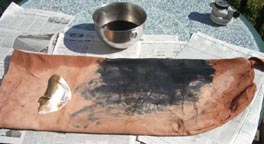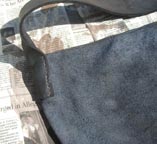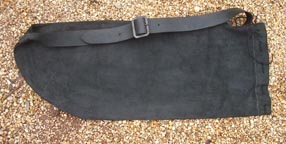 |
|
I do the occasional 17th century event, but snapsacks were also used through the 18th century. A friend who has been in the process of cleaning out his attic prior to a move gave me a bunch of leather in varying conditions. One piece was in pretty rough condition, stained and scarred, but was slightly bigger than 2' x 3', so I decided to make a snapsack with it. I've been thinking of making a linen snapsack, but they were also sometimes made of leather, and I thought it would be a fun thing to try, since I had an appropriate piece of leather. Links for snapsack instructions: |
|
I spoke with a friend who does 17th century reenacting, and was told that no existing examples of snapsacks have survived; we do have pictures, however. This made me feel more confident about changing a few of the details mentioned in the instructions above. The seam on the snapsack is sewn using a regular harness stitch. I attached the back end of the strap to the butt end of the bag before sewing the long straight seam down the bag's body because. I didn't like the idea of sewing the leather strap into the seam. That seemed likely to weaken the leather -- the stitching across the end of the strap would act like a perforated line along which the leather could part -- so I attached the strap with stitches on the side of the strap on either side of the butt seam. |
|
The dye used here is the vinegar + iron oxide recipe referenced in Recreating the 18th Century Hunting Pouch by T.C. Albert. Recipes using iron acetate or iron sulfate (aka copperas) have been used for centuries to dye leather and textiles. T.C. Albert recommends using old (unalloyed) steel nails or barbed wire etc. as a source for the iron oxide; I used steel wool, as recommended on a website I found when looking for more information on this dye recipe. I was expecting a dark cocoa brown dye from this recipe, based on the pictures in the book, but instead got a nice, dark black. I washed the bag twice after the dye dried to remove any excess dye, then rubbed neatsfoot oil into the leather to help waterproof the leather and make it more supple. Over time, iron will degrade both leather and textiles, and you can see this effect at work in surviving objects -- for instance, embroidered items will have deterioration of the yarns dyed with iron mordants, but the yarns dyed with other mordants are intact. In the term of these items' active use, this may not have enough of a concern to keep people from using these iron-based dyes. Some of the period recipes I've seen add logwood or nut galls the mix, which I may try in the future. Note: while Robert Haldane says it won't stain the hands -- it definitely will. Wear rubber gloves. |
|
|
|
|



